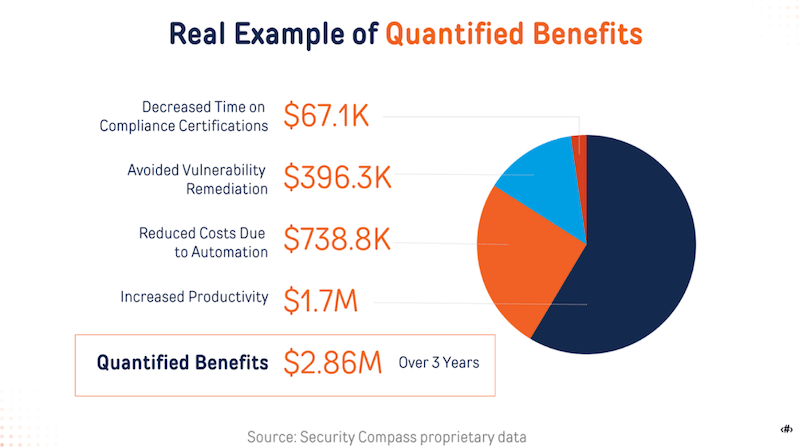In today’s fast-paced digital landscape, the importance of robust cybersecurity cannot be overstated. Security breaches can lead to significant financial losses, reputational damage, and legal consequences.
To mitigate these risks, businesses must adopt a proactive approach to cybersecurity. Security by Design proactively integrates security into every phase of the software development lifecycle, starting from the planning and design stages.
Let’s explore the key benefits and how to build a compelling business case for security by design.
Building a Business Case for Security by Design
Security by Design is a paradigm shift for most organizations. Switching mentalities from finding and fixing defects to building security requires organizational change management. We need to help answer the question, “Why do businesses need security by design? In our experience, it’s crucial to quantify benefits to gain buy-in from business stakeholders. Using your organization’s data to build the business case is ideal, but in many cases, organizations may lack the necessary data points.
Figure 1: Actual results of analysis from implementing a Security by Design program
Here, we provide metrics, formulas, and industry data to help you quantify a business case.
1. Reduce Operational Costs
Security by Design often offers the highest Return on Investment (ROI) among cybersecurity programs. While other initiatives aim to reduce the likelihood of a breach, Security by Design also reduces the costs of securing software compared to reactive approaches.
Here are three primary ways it achieves this:
- Avoid Vulnerability Remediation
Data from our customer base indicates that fixing an average vulnerability costs $50,156. Given that the average application has 38 high or critical-risk vulnerabilities. Implementing Security by Design can conservatively reduce vulnerabilities by 79% compared to simply testing for security issues after software has been built.. This results in significant cost savings per application. For example, a global company that adopted Security by Design could see estimated savings such as below:
- Decrease Time Spent on Compliance
Responding to audits and building artifacts to demonstrate compliance can be onerous for software teams. Taking a by-design approach with built-in audit trails allows organizations to reduce the time and effort required for compliance. This proactive approach ensures that security and compliance requirements are met from the outset, avoiding the need for extensive rework and penalties associated with noncompliance.
- Reduce Costs with Automation
While some security-by-design activities, such as threat modeling and security requirements generation, can be done manually, automation significantly enhances ROI. Automated tools reduce the person-hours needed to perform these tasks, leading to substantial cost savings. For instance, a company that automated its Security by Design processes saved $2.86 million over three years.

2. Reduce Risk
Another key benefit of Security by Design is a lower risk due to software due to preventing vulnerabilities in software. Risks are notoriously difficult to measure and communicate to business stakeholders. Many security organizations report on measures like the number of vulnerabilities and Mean Time To Remediation (MTTR) for security, but these aren’t necessarily meaningful to non-technical stakeholders.
An alternative method to measure risk in a way that’s more intuitive to a non-technical stakeholder is a window of exposure: The number of days that a high or critical risk vulnerability is in production. Since more than one vulnerability may be exposed simultaneously, it’s best to consider this a unit of measure rather than calendar days.
Quantitative Risk Analysis
FAIR provides a richer mechanism for expressing risk in business terms. Using quantitative methods, FAIR allows practitioners to express risk regarding loss exposure in dollars. In practice, FAIR has a learning curve and sometimes faces resistance from practitioners skeptical of quantitative risk management for cybersecurity. Using FAIR is outside the scope of this document, but we encourage you to consider it as a method of measuring risk to be presented to executives and boards.
3. Improve Software Security at Scale
Security by Design ensures that security practices are scalable and sustainable across multiple applications and projects. You can assess the impact of scalability in two ways:
- Determine the time saved per application using security by design vs. more reactive methods. This results in faster time to market.
- Determine how many applications a security architect, application security analyst, or other role can effectively serve with and without the security by design program.
Finally, if the program uses automation, you can also assess the speed of using automation compared to manual methods.
4. Grow Revenue by Demonstrating Compliance
Adopting Security by Design can open new market opportunities and enhance revenue growth by demonstrating compliance with regulatory standards. You can calculate the impact of demonstrating compliance to grow revenue in two ways:
- Estimated sales as a result of demonstrating compliance (or loss of revenue as a result of not showing compliance)
- Understanding the impact on the Total Addressable Market (TAM) as a result of obtaining compliance
Note that in many cases, compliance is not optional. In these cases, you may want to show how the security-by-design method of demonstrating compliance is more efficient than building software, finding audit defects, and fixing them. These calculations are already captured in the “Reduce Operational Costs” driver.